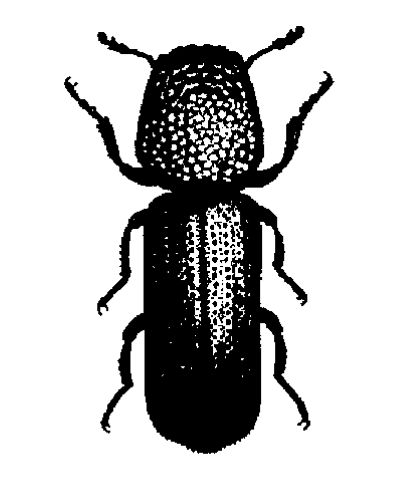Appearance
The adults of this beetle are very small (2 to 3 mm or 1/13 to 1/8 inches). They are dark brown to black in color. The body has a slender cylindrical form (Figure 1). The head is hidden under the slightly knobby, pitted prothorax. The elytra (hard, shell-like forewings) have distinct rows of pits running their length. The antennae have 10 segments with the last 3 enlarged, forming a loosely segmented club. The larvae are white, stout bodied, and c-shaped.

Habits
The lesser grain borer is characterized as both an internal and external feeder and is a serious pest of both whole kernel stored grain and cereal products. The adults and larvae bore into undamaged kernels of grain, reducing them to hollow husks. They are also able to survive and develop in the accumulated "flour" produced as the seeds are chewed up. The lesser grain borer is primarily a pest in stored wheat and corn, but it can infest tobacco, nuts, beans, bird seed, biscuits, cassava, cocoa beans, dried fruit, peanuts, spices, rodenticide baits, and dried meat and fish.
Biology
Adult females lay eggs singly or in groups of up to 30. The eggs are laid on the outside of the grain or in the fine powdered grain associated with infestations of this beetle. A female can lay from 200 to 500 white eggs during a lifetime. Development from egg to adult depends on temperature. In hot summer conditions it may take as few as 30 days, but the average is about 58 days. Pupation takes place inside the hollow shell of the seed or in the "flour" that accumulates with infested grain.
Control
Inspection is very important to prevent infested materials being brought in to infest other goods. Warehouses and stores, especially feed and health food stores, should monitor for beetle infestations with pheromone traps. Store whole grains such as bird seed, popcorn, wheat berries, spice seeds, dried beans, and seeds for sprouting in insect-proof glass, metal, or plastic containers. Infested products should be discarded. Infestations in homes are sometimes a result of grain-stuffed animals or other ornaments. There is an unpleasant odor associated with infestations of lesser grain borer that makes infested material unpalatable. Sanitation is very important in control of this and other stored product pests. Shelves should be vacuumed, paying careful attention to cracks and crevices, and wiped down with warm soapy water. Small, isolated infestations may be controlled with residual and space sprays. Large infestations usually require fumigation to control pest populations. Grain protectants are used to discourage infestations, but some are less effective against lesser grain borer than they are against other insects.